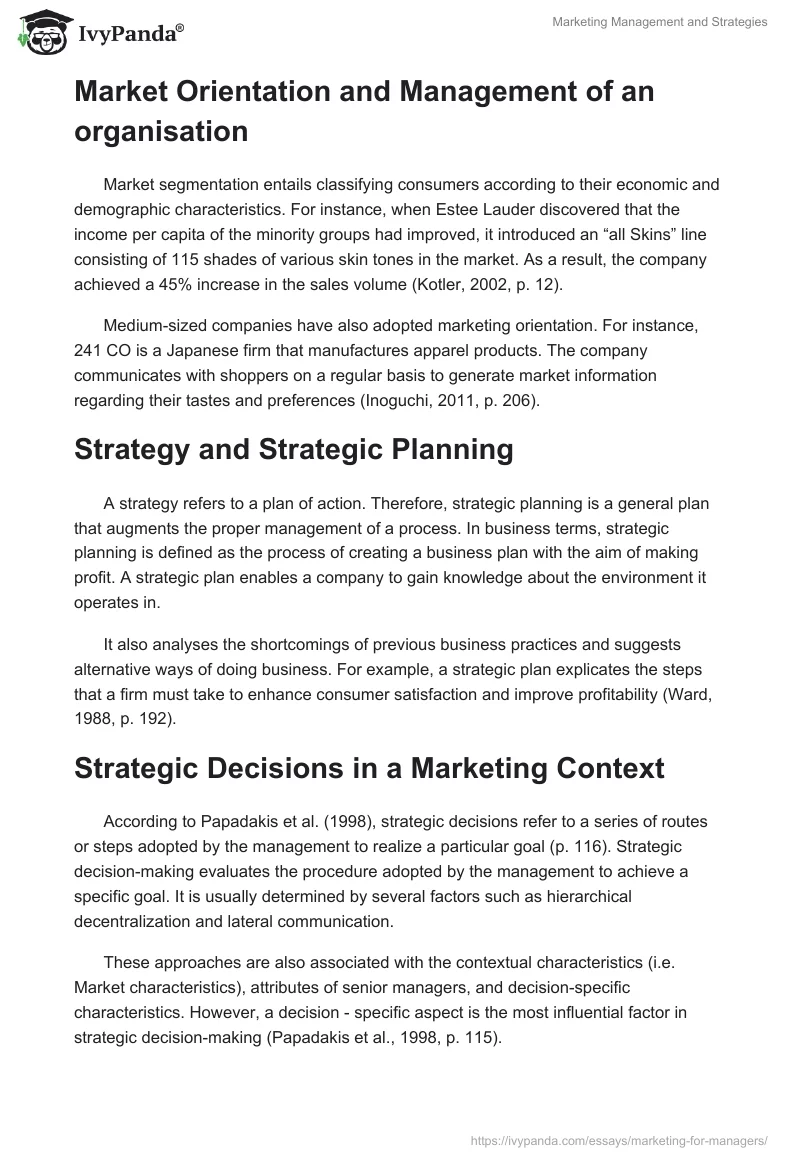Marketing Management
Marketing management is a procedure whereby people/groups produce and exchange good with others to fulfil their needs. Kotler (2002) defines marketing management as the “art of selling products” (p. 4). The aim of marketing management is to collect information relating to the tastes and preferences of consumers and creating goods that satisfy their needs.
Market segmentation entails classifying consumers according to their behavioural and economic characteristics. The firm then creates a market offering for the selected segment. For instance, the Volvo Company markets its automobiles to shoppers who value automobile safety (Kotler, 2002, p. 4).
Market Orientation
Market orientation is defined in terms of the behavioural and cultural approaches. Market orientation is a process of generating information relating to the present and future needs of shoppers and then distributing it across relevant departments (behavioural approach).
In other words, market orientation emphasizes organizational actions pertaining to the production, distribution and receptiveness of market information (Inoguchi, 2011, p. 201).
It also refers to an organizational culture which promotes activities that result in the production of high-quality products (cultural approach). Thus, it focuses on the values and norms of an organization that promote the production, distribution and receptiveness of market information.
Market Orientation and Management of an organisation
Market segmentation entails classifying consumers according to their economic and demographic characteristics. For instance, when Estee Lauder discovered that the income per capita of the minority groups had improved, it introduced an “all Skins” line consisting of 115 shades of various skin tones in the market. As a result, the company achieved a 45% increase in the sales volume (Kotler, 2002, p. 12).
Medium-sized companies have also adopted marketing orientation. For instance, 241 CO is a Japanese firm that manufactures apparel products. The company communicates with shoppers on a regular basis to generate market information regarding their tastes and preferences (Inoguchi, 2011, p. 206).
Strategy and Strategic Planning
A strategy refers to a plan of action. Therefore, strategic planning is a general plan that augments the proper management of a process. In business terms, strategic planning is defined as the process of creating a business plan with the aim of making profit. A strategic plan enables a company to gain knowledge about the environment it operates in.
It also analyses the shortcomings of previous business practices and suggests alternative ways of doing business. For example, a strategic plan explicates the steps that a firm must take to enhance consumer satisfaction and improve profitability (Ward, 1988, p. 192).
Strategic Decisions in a Marketing Context
According to Papadakis et al. (1998), strategic decisions refer to a series of routes or steps adopted by the management to realize a particular goal (p. 116). Strategic decision-making evaluates the procedure adopted by the management to achieve a specific goal. It is usually determined by several factors such as hierarchical decentralization and lateral communication.
These approaches are also associated with the contextual characteristics (i.e. Market characteristics), attributes of senior managers, and decision-specific characteristics. However, a decision – specific aspect is the most influential factor in strategic decision-making (Papadakis et al., 1998, p. 115).
Strategy, Planning, Strategic Marketing Decisions at Coca-Cola Company
Strategic decision-making is an important process that enables a firm to realize specific goals. Thus, moribund marketing decisions may result in poor performance. For example, the Coca-Cola Company experienced a decline in the sales volume in 1980s when it introduced New Coke in the market to replace the original Coke.
The loss was caused by poor market research which failed to capture the emotional attachment and symbolic value of the original Coke to consumers. In addition, the market research did not incorporate key variables relating to the spending behaviour of consumers (Smith & Albaum, 2010, p. 8).
References
Inoguchi, J. (2011). Implementation of Market Orientation in Small Sized Company: Case Study on a Japanese Apparel Manufacturer. Int. J. Emerg. SCI, 1 (3), 200-210.
Kotler, P. (2002). Marketing Management: Millennium Edition (10th ed.). Upper Saddle River, New Jersey: Prentice-Hall, Inc.
Papadakis, V., Lioukas, S., & Chambers, D. (1998). Strategic Decision-Making Processes: The Role of Management and Context. Strategic Management Journal, 19 (2), 115-147.
Smith, M., & Albaum, S. (2010). An Introduction to Marketing Research. Mexico City: University of Mexico.
Ward, L. (1988). The Special Role of Strategic Planning for Family Businesses. The Best of FBR II, 1 (2) 190-195.


